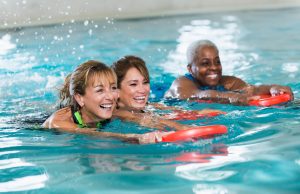How much studying does it require to become and remain a chiropractor?
At Spinavita Chiropractic, we have four qualified chiropractors who all graduated with a Masters of Chiropractic after four years of study at university. They are also registered with the General Chiropractic Council. In order to re-register with this governing body each year, chiropractors in the UK must complete 30 hours of “continued professional development” (CPD) every year for the rest of their career. 15 of those hours must be learning with others. As a clinic, we also think it is important to continue to learn, develop our skills and keep up-to-date with the most recent evidence.
This year, one of our chiropractors, Jennifer completed a Strength and Conditioning course for Therapists in order to build on her knowledge and passion for exercise prescription.
Read on to hear more about why Jennifer chose this course and what she has learnt.
Why do a strength and conditioning course as a chiropractor?
There is very high quality evidence and established guidelines throughout the healthcare sphere, that outline the benefits of physical activity in preventing and reducing musculoskeletal pain, in addition to exercise being used as a treatment modality for recovery from injury.
“Growing up, I was always very active and have felt the physical, mental and social benefits of being physically active. My main form of physical activity was dance (ballet, tap, modern and jazz). By participating in this, the specific strength work that I would complete within the classes as well as independently at home, gave me great insight in the importance of injury prevention as well as aid the improvement of the techniques required.
This interest in exercise prescription continued into university, particularly in the 3rd and 4th years of study where we had specific modules that delved into the most recent evidence for the types, frequency, duration and intensity of exercises required throughout the injury rehabilitation process.
Since graduating, I have continued to be very passionate about helping people reduce their pain and improve their function to get back to activities they enjoy by combining hands-on treatment techniques as well as introducing mobility and strength exercises. The guidelines that healthcare professionals should follow, that is based on well researched studies, highlight that management of low back pain for example amongst many types of musculoskeletal pain, can include manual therapy (such as chiropractic care) as part of a ‘treatment package’; of which should also include exercise.
Therefore, the importance of exercise prescription within the ‘package of care’ that chiropractors can provide is more important than ever with the emergence of this research. This spurred me on to undertake an official qualification to ensure that I was providing the most optimal advice relating to exercise prescription.”
What did Jennifer learn?
The strength and conditioning course Jennifer completed covered a large range of topics to include:
- Components of muscle strength
- Strength for joint stability and patient function
- Muscle loading for strength
- The repetitions maximum continuum
- The principles of training
- Fatigue and failure
- Neural (nerve) drive and recruitment
- Designing effective exercise programmes
- Dose-response for muscle strength
- Programming progressive resistance training
- Progressing and regressing resistance exercises
- Clinical considerations in exercise and rehab
- Exercise adaptation for patient populations
- Periodisation in strength and condition as well as in rehabilitation.
Jennifer’s strength and conditioning top tips:
- Follow the 3 principles of training required for optimally challenging your muscles:
- Specificity- Use particular exercises to improve specific outcomes towards your goal.
- Overload- Increasing the intensity of an exercise to a level that is higher than accustomed.
- Progression- Gradual increase of load to improve strength or distance run etc.
- For optimum strength gain, use a weight that you can perform 3-5 repetitions of to failure safely with the correct technique. This should be approximately >85% of your 1 rep max.
- It is important to plan your exercise programme to meet your specific aims. Thus, create a ‘hierarchy of importance’, which for most people recovering from injury for example, it will be strength first, then power and then followed by control. When meeting the aims of your activity, if it is for a specific sport, you must ensure you meet the demands of the sport or activity. Therefore, your training must meet your performance and functional needs, replicate the unpredictability of the sport and also build your tolerance against injury.
- Periodisation is the division of a large training period into smaller chunks, with review of specific goals in these smaller chunks of time. In the sports world, this is done to plan a change to the focus and load of an exercise at different periods of time in order to achieve peak performance at the most important points in the year e.g. an important competition. This helps prevent overburdening the neuromuscular system.
- Shouting or grunting during a set has been scientifically proven to increase ‘sympathetic drive of the nervous system’ which in turn increases muscle activation and force production!
How can a chiropractor help you?
Here at Spinavita Chiropractic, our chiropractors help people get back to activities they enjoy or support them as they embark on becoming more physically active. Our aim is to help you function at your best, including during exercise, for better overall health and happiness.
We have clinics in Hardwicke and Kingsholm with rehabilitation equipment available at both sites. Our Kingsholm satellite clinic is in a gym- the perfect location for one of our chiropractors to help you with exercise prescription and advice!
Call us on 01452 883232 or email enquiries@spinavita.co.uk to speak to one of our chiropractic team if you would like to discuss how we might be able to help you.
Get in touch with Spinavita Chiropractic
Call
Explore more
Articles
More about My Back Hurts: Is it damaged and am I damaging it more?My Back Hurts: Is it damaged and am I damaging it more?
By Jennifer Barr
Articles
More about Everything You Need to Know About Vitamin DEverything You Need to Know About Vitamin D
By Jessica Davy
Articles
More about Pelvic Floor HealthPelvic Floor Health
By Jennifer Barr
Articles
More about Menopause and Musculoskeletal HealthMenopause and Musculoskeletal Health
By Jessica Davy
Sign-up for updates
Join our community! Sign up for exclusive updates, wellness tips, and special offers delivered straight to your inbox.











